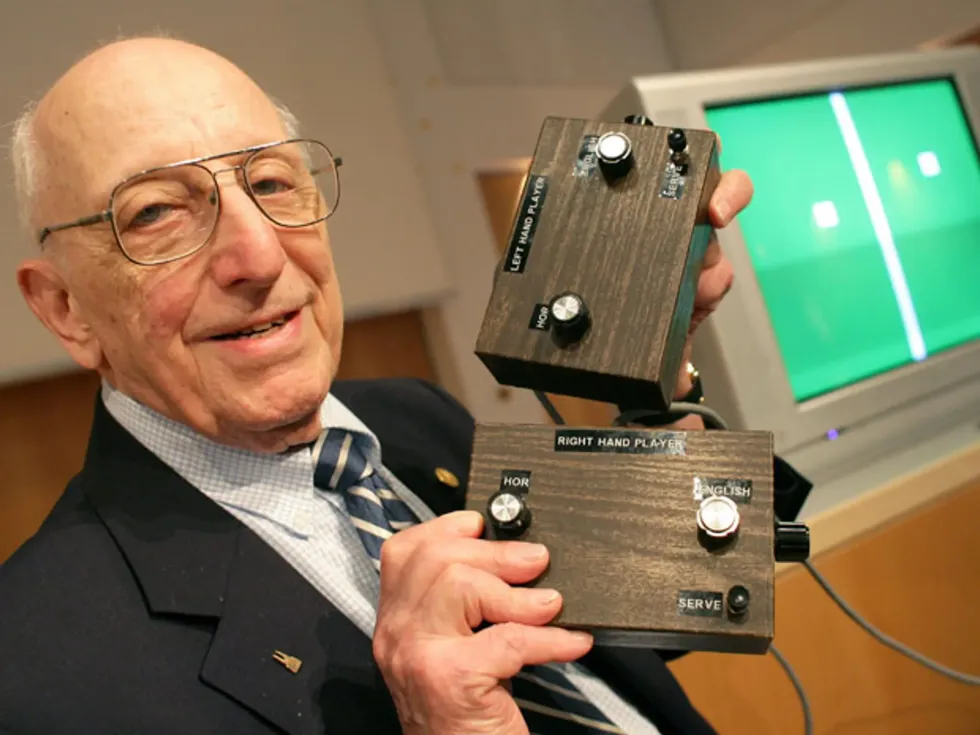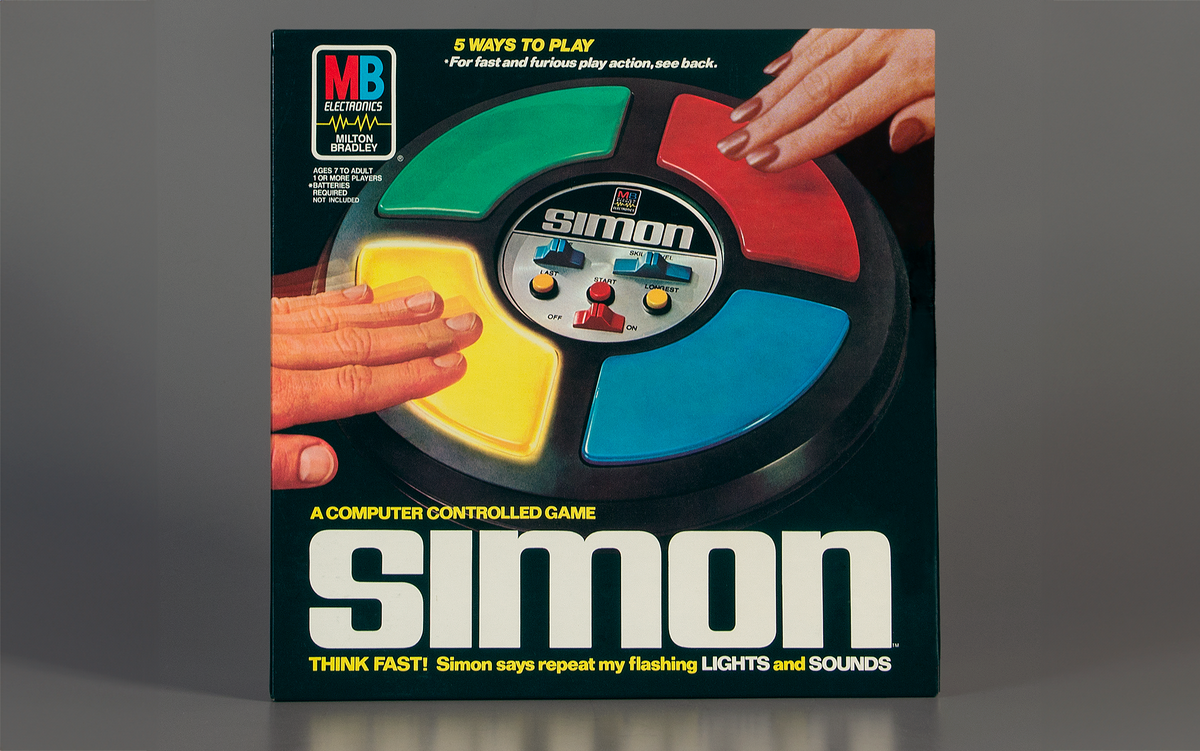In 1976, Ralph Baer and Howard Morrison, two game designers, happened to see a trade show demonstration of an Atari arcade game called Touch Me. The game’s waist-high cabinet featured four large buttons on the top, which lit up in random sequence; the player had to push the buttons in the same order.
The two found the idea of the Atari game intriguing but thought the execution was terrible. Baer later wrote that the game was “visually boring” and made “miserable rasping sounds,” in his 2005 autobiography, Videogames: In the Beginning (Rolenta Press).
Fortunately, Baer and Morrison were in a position to do something about it. Baer worked as a consultant for the Chicago-based toy company Marvin Glass. Morrison was a toymaker there. They decided to create their own light-up, pattern-matching game, but with more colorful buttons and pleasing musical notes.
In 1978, their game Simon was launched by Milton Bradley. The saucer-shaped, battery-operated plastic toy, which sold for US $25 (about $120 today), was an instant hit. And 45 years on, Simon is still being produced in several variations.
How the father of video games developed an electronic “Simon Says”
Baer was no stranger to game development. A decade earlier, he had invented the first home video-game system, which became the Magnavox Odyssey. The soundless multiplayer system included clear plastic overlay sheets that could be taped to the player’s black-and-white TV screen to add color, playing fields, and other graphics. Each game ran off a printed-circuit-board cartridge.

When Baer got the idea for his video-game system in 1966, he was the division manager at the defense contractor Sanders Associates (now part of BAE Systems) in Nashua, N.H. Games were pretty far afield from the company’s line of business, but Baer developed it anyway. Sanders Associates licensed the system to the TV-set maker Magnavox, and in 1972, the Odyssey was released.
Baer continued to work on electronic games. In 1973, while still employed by Sanders, he was hired as a consultant by Marvin Glass, according to The Strong National Museum of Play. His autobiography recounts how he routinely attended trade shows on behalf of both companies. That’s how he and Morrison wound up at the 1976 Music Operators of America trade show in Chicago, where they saw the demonstration of Touch Me.
The two began developing their own version the following year. Using Touch Me’s basic game play, they outlined the specs for their version, which they called Follow Me. The game’s original design featured a square console with four colored buttons—red, blue, green, and yellow—that would emit soft tones when lit up.
When the pair presented the idea to Marvin Glass’s managing partner Jeffrey Breslow, however, they didn’t even have a prototype. Instead, Morrison demonstrated how the game would work by tapping “buttons” on a paper sketch with his fingertips and humming the accompanying tones. It must have been convincing because Breslow approved the game’s development, and the duo got to work.
Baer and Morrison brought on computer programmer Lenny Cope, who had worked with Baer at Sanders. Cope suggested building the game around the Texas Instruments TMS1000 microprocessor. It was inexpensive and had 1,000 kilobytes of memory, and Cope had written the code for the chip’s programmable record changer.
“Writing programs for the TMS1000 in those days was a real chore,” Baer recalled in his autobiography. “We had a Teletype terminal, which Lenny used to communicate with a computer somewhere in Pennsylvania on which Texas Instruments’ program for the device was resident. The monthly telephone bills that ensued looked like the National Debt. And, of course, communicating at a couple of hundred baud (bits) per second took forever.”
Baer designed and built the 20-by-20-centimeter case that housed the TMS1000, read-only memory, and four lightbulbs for the buttons. The unit also contained a loudspeaker, transistor drivers, an on/off switch, a “start” button, and a switch that let users choose how many rounds they wanted to play—up to three, according to Baer’s autobiography.
To select the game’s four tones, Baer researched a variety of musical instruments, eventually choosing the notes G, C, E, and G played on a bugle. Baer, Morrison, and Cope were granted a U.S. patent for the game in 1980.
Milton Bradley, headquartered in East Longmeadow, Mass., bought the rights to the game after Millens W. Taft, Jr., its senior vice president of research and development, saw a demonstration. The company renamed the game Simon, after the classic children’s game “Simon Says,” which, Baer wrote, “made perfect sense.” After a few more tweaks—including making the plastic case round and adding three levels of difficulty—Simon was launched in May 1978 at Studio 54 in New York City. At the party, a giant replica of the game, 1 meter in diameter, descended from the ceiling at midnight as partygoers danced below. The game went on to be a huge hit during the Christmas season.
The evolution of Milton Bradley’s Simon
Over the years, many versions of Simon have been made.
In 1979, for example, Milton Bradley released Super Simon, a two-player game that tested which person could repeat the sequence faster. It was rectangular instead of circular and had two sets of four buttons laid out like piano keys.
A year later, the company released a miniature version called Pocket Simon. A keychain version came out in 1998. One shaped like Darth Vader’s head was introduced in 2017; it features the first four notes of Vader’s leitmotif. See for yourself:
Star Wars Simon Darth Vader Gamewww.youtube.com
The first wearable version—Simon Optix—was also released in 2017. Modeled after an augmented-reality headset, it lights up colors in front of the player’s eyes, and players have to repeat the pattern by waving their hands in front of the headset.
I never had my own Simon, but I remember playing it as a child at a family friend’s house. Their daughter, who was older than me, usually entertained me with board games while the adults were catching up with each other around the dinner table. During one of these get-togethers, I saw Simon sitting in the pile of boxes—the packaging was worn, seemingly well loved—and so I decided to play it. I only completed a couple of rounds, but I remember having fun. If I had known that Super Simon existed, I probably would’ve asked my parents to buy it for me so I could play with my friends. Did you play Simon as a child? What are your favorite memories of the game?
Part of a continuing series looking at historical artifacts that embrace the boundless potential of technology.
An abridged version of this article appears in the December 2023 print issue as “What Simon Says.”References
I began my research for this piece by reading The Institute’s articles about Ralph Baer.
For a better understanding of Simon’s history, I then read Baer’s autobiography Videogames: In The Beginning (Rolenta Press, 2005), which described how he and Howard Morrison developed the game as well as its technical aspects.
For information on the game’s impact on consumer electronics and the various versions of Simon that have been released since it first launched in 1978, I read articles from Fast Company, the National Museum of American History, and National Public Radio, as well as an oral history with Baer by the Computer History Museum.
Joanna Goodrich is the associate editor of The Institute, covering the work and accomplishments of IEEE members and IEEE and technology-related events. She has a master's degree in health communications from Rutgers University, in New Brunswick, N.J.



